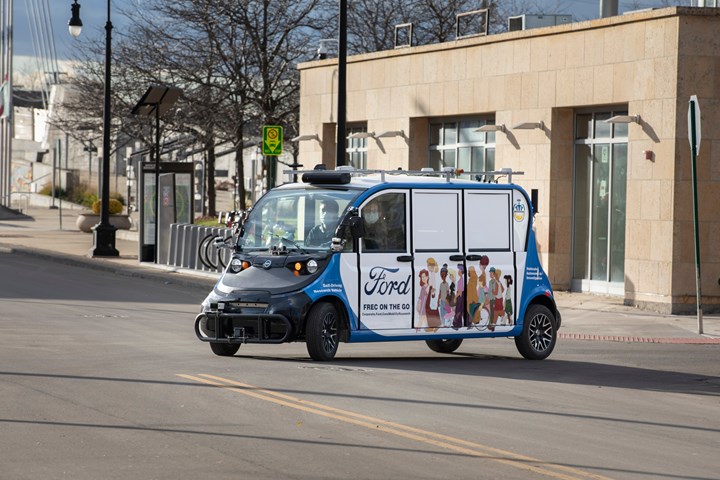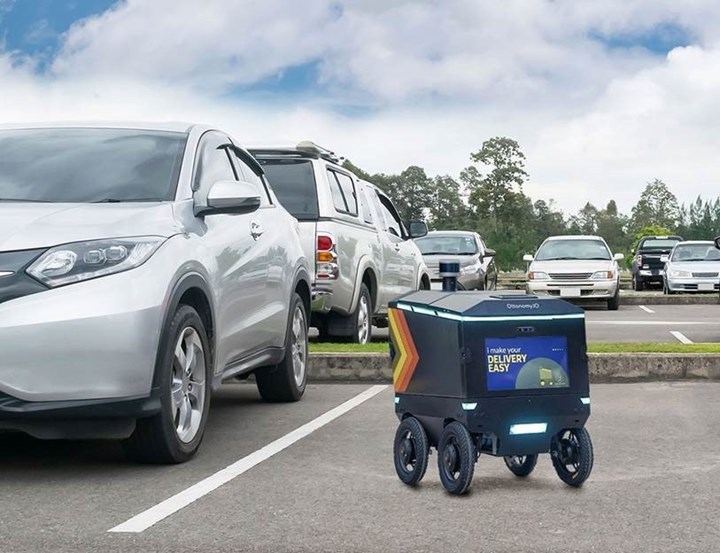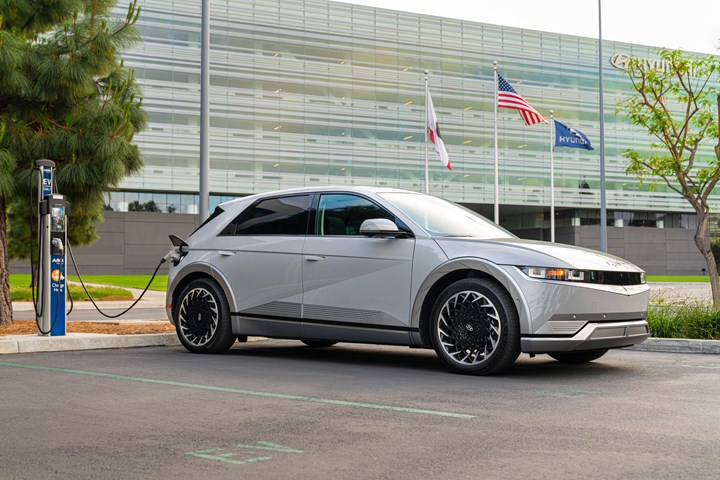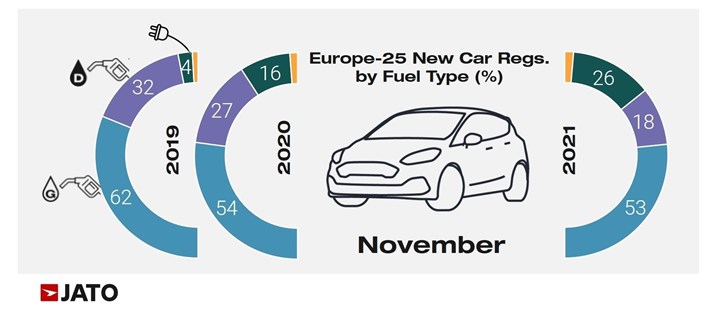On Electric Vehicles, Autonomous Vehicles & a Sled for Santa
Autonomous vehicles galore—from Ford delivering food to Santa delivering presents. A clever EV from Honda for hospitalized children. The impressive Hyundai IONIQ 5, and how the company got there. And more.
Autonomy for Good

Ford is running a program delivering fresh food to seniors in Detroit via an autonomous vehicle. Learning while doing good. (Image: Ford)
“Technology is only successful if it improves the lives of people.”
So said John Davis, Director of Autonomous Vehicle and Future Technology, Ford Motor Company.
That fundamental need for improvement is something that sometimes gets lost in discussions of tech developments.
Credit to him.
One of the things that Ford is doing to improve the lives of some Detroit seniors who have difficulty—due to mobility challenges—getting fresh, healthy food is running an autonomous low-speed shuttle to deliver food to them.
Ford is anticipating the delivery of 10,000 pounds of food per month.
It is a six-month pilot being conducted in coordination with the philanthropic arm of Ford, the Ford Motor Company Fund.
According to Davis the program will allow Ford to:
- Perform autonomous testing. They started with a GEM e6 and fitted it with lidar, radar and cameras, as well as a self-driving system the team developed. There is a safety driver on board. In addition, the shuttle is being autonomously monitored by a Ford subsidiary, Quantum Signal AI. Sensor nodes are deployed on the fixed route of the shuttle, to help provide more information to the vehicle.
- Assess design. The Ford Experience Design team is assessing the overall vehicle design as well as the human interface with the vehicle.
- Do good. Davis: “How we can support the community and address the needs of historically under-represented and under-served groups through future mobility services , while building trust in mobility innovation like autonomous vehicles.”
Credit to Davis and his team.
///
AVs for Food Service

When you can’t get a food delivery person to take the order out to the parking lot, let the autonomous vehicle do it. (Image: Ottonomy)
In other food-related autonomous vehicle news. . . .
What do you do when you can’t get help for your restaurant (as seems to be the case everywhere due to the on-going pandemic)?
Perhaps turn to “a leading provider of restaurant labor productivity technologies,” Presto.
(Incidentally: those productivity technologies are not faster quick fryers or the like but “conversational AI, computer vision, and integrated touch.”)
And if you are Presto and looking for more tech?
Create a partnership with a company that provides autonomous delivery vehicles, in this case, Ottonomy.
The electric autonomous delivery vehicle uses lidar, cameras, GPS, ultrasonic sensors, and an inertial measurement unit that allows it to operate indoors and out. It is connected to the cloud but does edge computing. It has “multilayered safety subsystems” to protect pedestrians and “situational awareness” to operate in areas with people.
The vehicle, which has a stainless-steel body, can operate for six hours and requires a one-hour recharge time. It weighs 100 pounds.
Top speed? Five miles per hour.
///
Hyundai’s Journey to the IONIQ 5

The Hyundai IONIQ 5 electric crossover. Engineered to spend minimal time at the charging station. (Image: Hyundai)
Undertaking a transformation from being a provider of conventional transportation (though by no means abandoning things like vehicles with thermal engines, because transformation doesn’t happen overnight so look for the continuation of hybrids, plug-in hybrids and, well, efficient internal combustion engines for some time to come) to being a provider of smart, eco-friendly mobility
This takes the form of a variety of modes of transport. For example, Hyundai is partnering with Aptiv in Motional; the mission statement of the company, which has been doing extensive work with Lyft in Las Vegas on autonomous driving: “We're making driverless vehicles a safe, reliable, and accessible reality.” They are putting vehicles on the road and passengers in seats.
Hyundai has established Supernal, which is dedicated to advanced urban air mobility, and which plans to have an eVTOL (electric vertical takeoff and landing) craft in the skies by 2028.
And more immediately, Hyundai is launching the IONIQ 5, an electric crossover based on the company’s new global electric vehicle platform, e-GMP.
No Stranger
Hyundai has actually been working on electric vehicles (EVs) for a non-trivial amount of time given that Hyundai Motor Company has existed only since 1967.
It started in 1991 with the Sonata EV, then worked on Accent and Santa Fe versions in subsequent years. Those, along with something called BlueON, were development vehicles. In 2015 it launched the Ioniq (in the U.S. market in 2016), which came in three flavors—hybrid, plug-in hybrid and EV—all of which were market-available vehicles (one could say “mass production,” but in pre-COVID 2019 just 19,574 Ioniqs were sold in the U.S., so spread over three vehicles, not particularly massive). The Ioniq EV had a 124-mile range (MY 2021 got it up to 170 miles).
It was followed in 2018 by the Kona EV, a compact crossover, with a 258-mile range. (And it shouldn’t go unmentioned that it has developed an array of hybrids, plug-in hybrids and even fuel cell electric vehicles beyond the Ioniqs. Arguably Hyundai has the widest array of powertrain offerings among any OEM. Any.)
What Is the IONIQ 5?
A fully electric crossover.
But a little orientation can be helpful.
Let’s put it into context with vehicles in its space that have already been introduced. Its competitive set includes the Ford Mustang Mach-E, the Volkswagen ID.4 and the Tesla Model Y.
Not to underestimate the Tesla Model Y in the market, odds are probably good that there are those who buy or want to buy a Tesla and those who are willing to consider EVs from mainstream brands, with very little overlap. So we’ll just put the IONIQ 5 in relation to the Ford and the VW.
IONIQ 5 Mach E ID.4
Length (in.) 182.5 185.6 180.5
Height 63.2 64 64.4
Wheelbase 118.1 117.4 108.9
Pass. volume (cu. ft.) 106.5 101.1 99.9
Cargo volume 27.2 29.7 30.3
Drag coefficient 0.29 0.29 0.28
MPGe 132 101 97
All essentially in the same space dimensionally, but in terms of the MPGe of the vehicles there is certainly a non-trivial delta.
As mentioned, the previous EV brought out by Hyundai was the Kona EV and how the company has built on its learnings from that vehicle is notable:
Output Energy System Weight Energy Density
Kona EV 170 kW 64 kWh 453 kg 141.3 Wh/kg
IONIQ 5 >250 kW 77.4 kWh 482 kg 151.5 Wh/kg
Another way of looking at that is to say that there is impressive efficiency for the IONIQ 5.
This gets a little tricky.
If you want to get the headline regarding range know that the least amount is an estimated 256 miles and the longest is 303 miles.
The (slightly) complex bit:
There are two lithium-ion polymer battery pack sizes: 58 kWh and 77.4 kWh. (Batteries are supplied by SK Innovations; the batteries use nickel manganese cobalt oxide (NMC) chemistry.)
There are two drive configurations: rear-wheel or all-wheel drive.
There are two rear drive motors: 168 hp and 225 hp.
There is one front-drive motor: 99 hp.
The 58-kWh pack is available with RWD. The 77.4-kWh pack can either be RWD or AWD.
When going with the top-of-the-line rear and front motors, the combined output is 320 hp.
All versions have a top speed of 115 mph. And can tow a 2,000 trailer.
Charged
One of the things that is a concern among people when it comes to EV operation is that recharging time can essentially require plugging in to the public charger that is probably located in the parking lot of a shopping mall, then going shopping and having lunch, to boot. Hyundai has addressed this by having an 800-volt capacity charging system, which means that in 18 minutes the battery can go from 10% to 80% charge. Still three times longer than pumping in liquid fuel, but faster than the amount of time it would take to get the same amount of energy into a Model Y, according to Hyundai.
For those who are in more of a hurry, the IONIQ 5 can get 68 miles of range on a >250 kW DCFC (800 V) charger in five minutes and 42 miles of range on a 150-kW DCFC (800-V) charger.
It is interesting to note that there is what is called “V2L” functionality, as in “vehicle-to-load.” This means that on-board electricity can be used to power things like phones, computers and. . .even other EVs. There is 1.9-kW peak power with a standard 120-V outlet.
Free Electrons
Hyundai is offering free, unlimited, 30-minute charging sessions on the Electrify America network for two years from date of purchase.
Inside
The instrument panel is dominated by two screens: a 12-inch gauge cluster and a 12-inch touch-sensitive infotainment screen directly to the right of the gauge screen. There is no need for a hood to shade either.
Another screen is the windshield; there is a head-up display with augmented reality that uses the windshield to display information.
There is an actual volume knob and a physical tuning switch. Selecting the map, navigation, media type, favorites, and vehicle camera is preformed with buttons. They haven’t gone all-touch interface, which is a good thing.
In keeping with the “green” nature, interior surfaces (e.g., seat, headliner, arm rests, floor) are covered with materials including recycled PET bottles, plant-based yarns, and bio-paint with plant extract. (No, you can’t tell).
Impression
The exterior styling is contemporary without being like something out of a bad science fiction film. A theme that is found outside (e.g., tail lamps) and inside (e.g., seat surface) is that of pixels, or square shapes providing a subtle digital design. Just enough futurism.
The flat floor makes the interior roomier than it might otherwise be, to say nothing of the long wheelbase (118.1 inches).
Thanks to the low center of gravity, the vehicle is planted, even when driving through curves that would otherwise require a lower speed or a tolerance for skidding.
The base model has an MSRP of $39,700. So with the $7,500 federal EV tax credit that goes down to $32,200. (According to Kelley Blue Book the average transaction price for a non-luxury vehicle in November 2021 was $43,144, which makes the top-of-the-line IONIQ 5 MSRP of $54,500 look awfully good for such a technologically advanced vehicle.)
///
You Meet the Nicest People on a Honda

Driving through Children’s Health of Orange County on the Honda Shogo—a real EV. (Image: Honda)
If this doesn’t make you feel good about Honda, have someone check your pulse. . .
“As someone who spent time in the hospital as a young child, I really wanted the number one objective of our Honda team in developing Shogo to ease the hardship of a hospital stay by providing kids a lasting positive memory about that experience. Every element of Shogo was designed to accommodate different needs of young children, making it as easy as possible to get in and out, simple to drive, and for the entire experience to leave them a bit happier.”—Randall Smock, senior exterior designer, American Honda
Shogo?
An electric ride-on vehicle developed by Honda designers and engineers to transport children through the hallways at Children’s Health of Orange County (CHOC).
The vehicle—the name means “soaring into the future” in Japanese—has a central seat and easy access. There are steering controls for a child (the ages it is intended to handle are 4 to 9). It has a horn with different sound options.
There is an IV pole holder in the back as well as a push bar that can allow manual propulsion. For the children there is a toy bucket in the front (frunk?).
And, of course, cup holders.
Shogo has a top speed of 5 mph, but its speed is set by hospital administrators.
Presently it is throttled at 2 mph (still plenty fast in a hospital corridor!).
Development
The Honda team worked closely with CHOC staff to develop the vehicle. A course was created at the Honda R&D facility that replicated a hallway in the hospital, and children and parents were brought in so that the testing could be performed in as real an environment as possible.
Brianne Ortiz, manager of the Cherese Mari Laulhere Child Life Department at CHOC:
“We were impressed from the beginning when we first saw Shogo, and by the Honda team’s dedication in collaborating with our staff to ensure a vehicle that is perfect – and safe – for our young patients.”
Here’s hoping all of those patients soon get to ride home soon in mom or dad’s car!
///
The Diesel Decline

The European market is undergoing a shift in powertrain selection. (Image: JATO Dynamics)
It is hard to know where to start when it comes to surprising figures for European vehicle sales in November.
How about that, according to JATO Dynamics, there were total sales of 855,281 vehicles across 25 markets, which was. . .
- Down 18% compared to November 2020
- Down 29% compared to November 2019
- The lowest number for November over the last three decades
Yes, blame it mainly on the chip shortage.
As JATO Dynamics’ Felipe Munoz puts it, “The current problem does not relate to a lack of demand, but rather a lack of supply.”
Another surprise: the popularity of what are described as “low-emissions cars” vs. diesel vehicles (which still have that reputation as being something other than low-emissions (despite the fact that they are, now)).
Note not only that there has been an annual (November) decline in diesel share of the market. . .
- 2019: 32%
- 2020: 27%
- 2021: 18%
. . .but that low-emissions vehicles have had a notable growth. In November 2021 low-emissions vehicles outsold diesels by 41%.
That said, gasoline-powered vehicles had sales 2.1x greater than the low-emissions vehicles, so they’re not out of the game yet.
In addition to which. . .
According to French analyst firm Inovev, 26 models will be launched in Europe by Japanese OEMs in 2022-23 of which just five will be sedans.
They are:
- Honda Civic
- Mazda 2
- Mitsubishi Space Star
- Subaru Impreza
- Toyota Prius V
For the first 10 months of 2021 sedans still had the biggest market segment, 56%, with SUVs at 42% and MPVs (think: van) at 2%.
Unlike the U.S. market, pickup trucks are not much of a factor in European light vehicle sales.
///
And Finally, Santa Claus

Researchers at Coventry University have developed an autonomous sleigh for Santa. He may have to work from home this year, but that won’t stop him. (Image Coventry University)
With the pandemic situation in the UK being what it is, researchers at Coventry University’s Centre for Future Transport and Cities have come up with a way to allow Santa Claus to deliver presents while abiding by the UK government’s COVID recommendations (“Plan B”).
Paul Herriotts, Professor of Transport Design at Coventry University, said: “As Father Christmas is following Plan B guidance to work from home this year, we are helping him out with a self-driving autonomous super-sleigh; so there’s no need to worry--all the presents will be delivered on time this Christmas.”
(And yes, the folks at Coventry are developing autonomous vehicle tech for the rest of us.)
Merry Christmas!
RELATED CONTENT
-
On Fuel Cells, Battery Enclosures, and Lucid Air
A skateboard for fuel cells, building a better battery enclosure, what ADAS does, a big engine for boats, the curious case of lean production, what drivers think, and why Lucid is remarkable
-
Behind the Chevrolet Bolt
There are some cars that are simply profoundly important than others, and when it comes to cars introduced of late, the Chevrolet Bolt is certainly one of those particularly notable cars.
-
On The Jeep Grand Cherokee, 2022 Nissan Pathfinder, and More
An inside look at the Detroit Assembly Complex-Mack; a innovative approach to waste-free, two-tone painting; why a forging press is like an F1 car; and other automotive developments.


.jpg;width=70;height=70;mode=crop)






